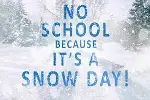|
Schools Turning to E-Learning on Snow Days
January 16, 2019 The tradition of a snow day–on which a school does not open because bad weather, usually snow and/or ice, makes it unsafe to travel–is an old one. Some teachers and administrators routinely brave the weather to go to school on snow days, if only to catch up on workload. For students, though, it's a day out of school. 
A great many school systems in the U.S. require students to attend for a certain number of days a year and, further, break down the school day into hours and even minutes in order to try to accommodate for the possible loss of an entire day because of bad weather. Common responses by school administrators to snow days are adding a day at the end of a term or year or adding a few minutes onto the end of each school day. Those are technical issues. More important to many parents and educators are the lost learning. Not very common are the students who keep on doing schoolwork when school is closed on a snow day, primarily because their schoolwork would be done at school. Now, however, some schools are turning to electronic solutions to keep students learning if they're not at school. One district in South Carolina has given each student an electronic tablet containing assignments to finish and submit if school is closed. The cause of closure doesn't have to be bad weather. The so-called "e-learning day" has supporters in other states as well. The solution works for students whose districts or parents can afford to provide such solutions. 
Another such solution involves using the Internet to transmit assignments back and forth between teachers and students–a practice that many schools already employ. Such a solution requires students to have Internet access; a great many do not have such access at home or easy access to a library or other public institution that might offer Internet access. Also possible as a stumbling block is the availability of Internet access at all. Many powerful storms wreak havoc with electricity and telephone lines. An absence of power and/or phone line access would make using the Internet extremely problematic. The only solution at that point might be using a device that can access a cellular signal, like a smartphone. Again, cost of such items is a factor. As well, bad weather can interfere with cellular communications. Schools in at least four U.S. states are going ahead with e-learning days, another way in which schools are turning to technology to try to solve problems. Closing school because of bad weather is much more prevalent than widespread power loss, and so these schools look to get reliable data on how well their programs worked–and how much their students worked, on days when they otherwise would not have. |
Social Studies for Kids |
Social Studies for Kids
copyright 2002–2024
David White




